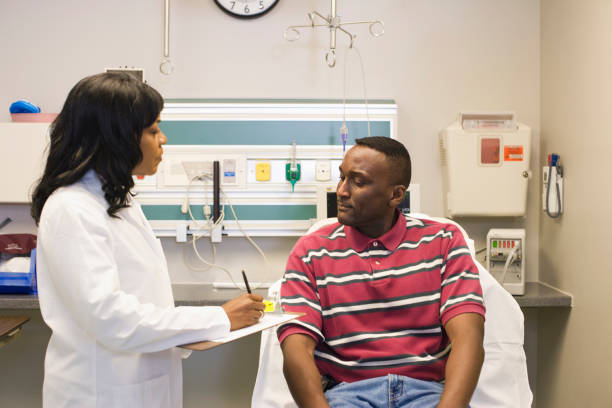
Let’s start with the truth: early detection can save lives. But here’s another truth — not every diagnosis leads to healing. In some cases, too much testing and too much treatment can cause more harm than good.
That’s the hard reality of today’s healthcare system — a system where we’re told to “be proactive,” to “get screened early,” to “play it safe.” And yet, for many people, especially in Black and Brown communities, these messages often exist alongside real fears of being overtreated, ignored, or misunderstood.
So, how do we strike a balance?
How do we protect ourselves through early detection without falling into a cycle of unnecessary interventions, anxiety, or procedures we don’t fully understand?
RELATED: Beyond Mammograms: The Quest for Early Detection and Equal Healthcare
The Issue of Overdiagnosis
Let’s define it plainly:
➤ Overdiagnosis is when you’re diagnosed with a disease or condition that would never have caused harm in your lifetime.
It’s not a misdiagnosis. The condition is real — it’s just not dangerous. And the harm comes when that diagnosis leads to treatments, surgeries, or medications that aren’t needed.
Take this in: not all abnormalities on a scan mean danger. Not every “positive” test means action is required. But we often act like they do — out of fear, out of habit, or because we’ve been taught to.
Overdiagnosis is more common than most people realize. It’s been widely studied in cancers like prostate, thyroid, and breast cancer — where increased screening has led to a higher number of diagnoses, but not always better outcomes.
This doesn’t mean screenings are bad. Far from it. But it does mean we need to have nuanced, informed conversations — with our doctors and within our communities — about when and how we screen, and what we do after.
RELATED: Prostate Cancer: Screenings Vs. Early Detection (They’re Not The Same)
The Causes & Consequences of Overdiagnosis in Healthcare
Overdiagnosis doesn’t happen in a vacuum. It’s a symptom of deeper systemic issues in how medicine is practiced and delivered — especially in high-income countries like the U.S., where the healthcare industry is fast-paced, profit-driven, and often risk-averse.
Here are some of the key causes:
1. More Advanced Technology = More “Findings”
Modern imaging like MRIs and CT scans are powerful — but that also means they can pick up tiny, harmless abnormalities that would’ve gone unnoticed (and untreated) decades ago.
Example: Up to 70 percent of thyroid cancers found through ultrasound screening are low-risk tumors that would never have grown large or spread — but many still get surgically removed.
2. Fear of Missing Something
Doctors want to help. And in today’s medical-legal environment, they’re often pressured to “rule everything out” to avoid being blamed later — even if it means ordering more tests than necessary.
3. Medical Culture that Favors “Doing Something”
There’s a deeply embedded belief that more care = better care, even when “watchful waiting” or “doing nothing” might be the safer option. Many patients feel anxious when a doctor suggests not acting right away.
4. Industry Influence and Screening Campaigns
Pharmaceutical companies, device manufacturers, and even some nonprofit health campaigns encourage frequent screenings — sometimes without highlighting the risks of false positives, anxiety, or overtreatment.

RELATED: Early Detection of Alzheimer’s Makes a Difference
The Consequences Can Be Harmful
Overdiagnosis might sound like a minor issue, but it’s not. It can lead to:
- Unnecessary treatments (surgery, radiation, medications)
- Side effects from those treatments
- Emotional stress and anxiety from a diagnosis
- Financial strain, especially for uninsured or underinsured patients
- Medical trauma or mistrust — particularly for people who already face healthcare disparities
For Black patients, these consequences are layered with existing health inequities. Studies show that we’re more likely to receive more aggressive care, less likely to have our pain taken seriously, and often left out of decision-making conversations.
That’s why talking about overdiagnosis is a racial justice issue too.
RELATED: Why is Lung Cancer Early Detection Important?
The Impact of Unnecessary Medical Interventions
Medical care is supposed to help us heal — not create more harm. But when tests or treatments aren’t necessary, they can actually introduce new problems.
Let’s break this down:
1. Surgical Risks
Removing a thyroid for a small, slow-growing tumor might lead to lifelong hormone therapy. A prostate biopsy can cause infections or incontinence. Every procedure has risks.
2. Medication Side Effects
Treating a condition that wasn’t going to cause harm can still involve medications that affect your liver, kidneys, or mental health. Some meds have long-term effects we’re just beginning to understand.
3. Psychological Harm
Being labeled as “sick” — even if you feel fine — can change how you see yourself. It can cause stress, sleep issues, and anxiety. This is especially true for people dealing with PTSD from past medical experiences or systemic bias.
4. Financial Burdens
Unnecessary procedures often come with bills: imaging, lab work, copays, follow-ups, and prescriptions. These add up quickly, especially for those already struggling with access to care.
Guidelines for Patients to Make Informed Decisions About Screenings & Treatments
So now that we understand the problem, how do we protect ourselves without missing what matters?
Here are a few grounded, empowering steps to help you navigate this with confidence:
1. Ask “What happens if I do nothing?”
This is a powerful question. It reminds your provider to explain not just the risks of not acting, but also the possible benefits of waiting. Some conditions may never progress. In that case, monitoring may be the better choice.
2. Request Clear Risk-Benefit Information
Don’t settle for “this is standard.” Ask:
- What are the chances this condition will actually cause harm?
- What are the risks of the treatment being offered?
- What does the latest research say about outcomes?
You have the right to understand, not just comply.
3. Learn About Screening Guidelines
Different organizations offer guidelines for screening based on age, risk factors, and family history. Knowing when to screen — and when not to — can help you avoid unnecessary tests.
Here are reliable places to check:
4. Make Space for Shared Decision-Making
The best care happens with you, not to you. Your doctor should involve you in every step. If they’re rushing, dismissing, or pressuring you — it’s okay to pause, get a second opinion, or bring in an advocate.
5. Center Your Values
What matters most to you? Longevity? Quality of life? Avoiding certain side effects? Your care should reflect your values — not just statistics.
For example, someone with a family history of aggressive cancer might choose early screening. Another person might choose to wait. Both are valid — if they’re informed decisions.
Your Health, Your Voice, Your Power
Navigating health care is hard — and it’s even harder when you’re carrying the weight of medical trauma, systemic racism, or simply trying to survive in a system that often puts profits over people.
But here’s the truth: you are not powerless.
You have the right to:
- Ask questions
- Slow things down
- Decline unnecessary tests
- Seek second opinions
- Make choices that reflect your values
And more than anything, you have the right to be seen as a whole person — not just a set of symptoms or scan results.









